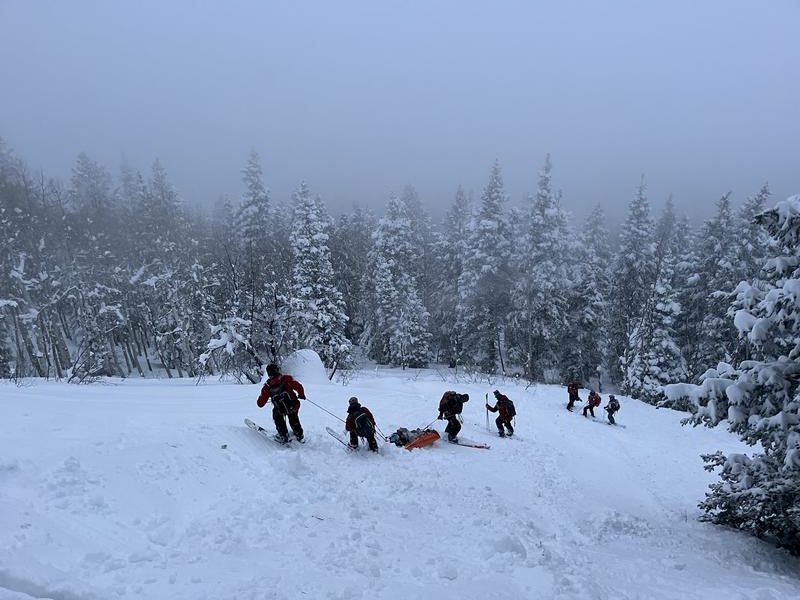
Two skiers were exiting a drainage in low elevation, north-facing terrain in Little Cottonwood Canyon on Tuesday when one of them was caught, carried, and partially buried by an avalanche. The skier was reported to have been seriously injured, with search and rescue teams having to evacuate them from the mountainside, according to the Utah Avalanche Center.
The UAC has released a preliminary avalanche accident report, which is attached below:

Preliminary Report
Two skiers were exiting the Red Pine Drainage in Little Cottonwood Canyon. While doing this they were below the summer hiking trail. The first skier triggered the avalanche just northeast of Pink Pine Ridge (see map below). As the second skier followed some distance behind the first, she saw there had been an avalanche. She started searching for the other skier with her transceiver, but then she saw him on the surface of the snow and called 911. The first skier sustained serious injuries.
Rescuers from Wasatch Backcountry Rescue, Snowbird, and Alta Ski Patrols responded and transported the injured skier out downhill towards the Tanners Flat Campground, across Little Cottonwood Creek, and to an ambulance. More details to follow after an accident investigation.

Terrain Summary
This was a steep north-facing slope at 7800′ above Little Cottonwood Creek and below the summer hiking trail.

Weather Conditions and History
After a long dry spell in November, the snow surface faceted throughout the Wasatch. This layer was buried on or around November 27th. Alta reported 38.5 inches and 1.96″ of water in this most recent storm which is ongoing.

The UAC shared the following regarding the avalanche danger for Tuesday, December 13:
The avalanche danger is CONSIDERABLE on all upper elevation aspects and mid and lower-elevation aspects facing northwest through east aspects where natural and human-triggered avalanches may break 1-4′ deep and 200′ wide, failing on a persistent weak layer of faceted snow. The avalanche danger is MODERATE on west-south-southeast aspects.
The north-facing slopes that are harboring old weak faceted snow surfaces are not to be messed with.
At the time of this writing, upper Little Cottonwood Canyon has received a storm total of 60″. Avalanche danger is currently elevated, and caution when navigating through the backcountry is critical right now.


Slope angle ? Slope angle ? Use a clinometer ? I don’t see the slope angle in these comments or reports. Use a fancy REI compass with a dip meter, and angle meter ?
Years ago I studied rock mechanics and soil mechanics and landslides and mudslides and snow avalanches,,, There is a basic earth-truth: The Angle of Repose… about 33 degrees for a pile of loose sand, maybe steeper for gravel with angular boulders… Snow is a weird metamorphic material because some of it freezes into crust layers, some of it forms hoar frost crystals and some of it rots into “bottom rot” aka “depth hoar” aka “facetts” (such a stupid term) when heat comes up from the ground, …depth hoar has about 85 percent porosity filled with stale air and near zero coefficient of sliding friction. Basic mechanics ??
This graph from the Dyatlov chapter shows that most avalanches come down at about 30 to 40 degrees slope angle. Funny thing about that. Sorry, it won’t cut and paste. Oh well… The Dyatlov Pass graph shows a bell curve with most avalanches coming down at 30 to 40 degree slope angle “based on Canadian and Swiss data” ..So ? What was the slope angle for that avalanche ?
I used to ski with a Denver-based group of backcountry skiers – Most are still alive – Because we had fun doing telemark turns on not-so-steep slopes and so we avoided steep slopes. One day we broke trail along a high ridge – east of Vail’s Back Bowls. Our leader used an REI compass with an angle meter. He kept asking us: “Who is getting creepy feelings? Who thinks this slope is too steep ?” Then he called out the slope angle. Most of the creepy feelings = intuitive danger signals – were at about 27 degrees slope angle. The leader had been reading CAIC avalanche reports.. When CAIC sends out their experts – a day or two after the slide – they always measure and report the slope angle. Most of the avalanches that season were coming down at 35 to 45 degrees. ??? So our group’s collective creepy feelings were warning us that the slope was dangerous- with a safety factor. ???
Most of us are still alive.